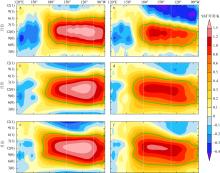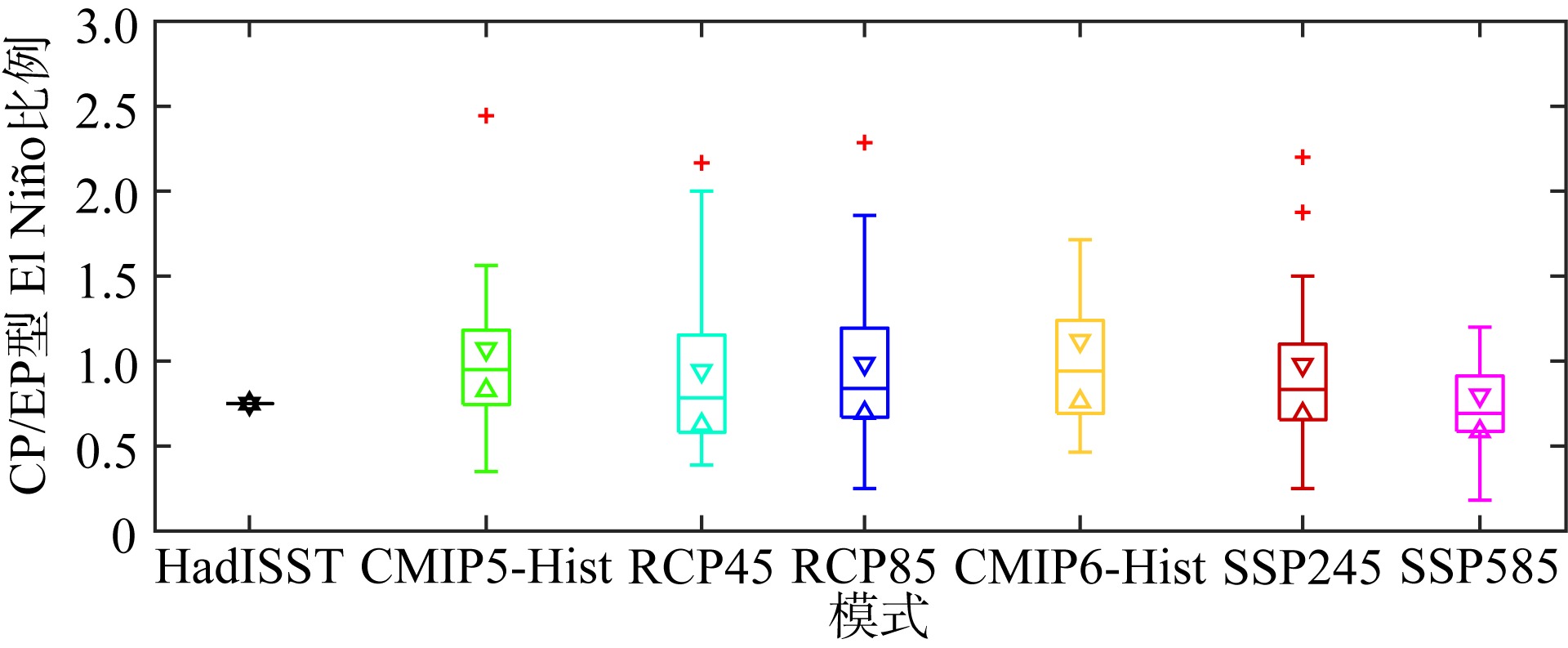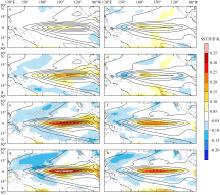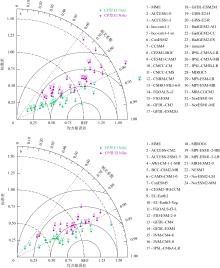Journal of Tropical Oceanography ›› 2023, Vol. 42 ›› Issue (2): 21-33.doi: 10.11978/2022067CSTR: 32234.14.2022067
Special Issue: 全球变化专题
Previous Articles Next Articles
Assessment of El Niño diversity simulations using CMIP6 and CMIP5 models*
WANG Weiqiang1,2( ), ZHANG Xiya1,3, XU Kang1,2, LI Junling1,3, MIAO Haoyu1,3
), ZHANG Xiya1,3, XU Kang1,2, LI Junling1,3, MIAO Haoyu1,3
- 1. State Key Laboratory of Tropical Oceanography (South China Sea Institute of Oceanology, Chinese Academy of Sciences), Guangzhou 510301, China
2. Southern Marine Science and Engineering Guangdong Laboratory (Guangzhou), Guangzhou 511458, China
3. University of Chinese Academy of Sciences, Beijing 100049, China
-
Received:2022-04-07Revised:2022-05-24Online:2023-03-10Published:2022-05-24 -
Contact:WANG Weiqiang. email:weiqiang.wang@scsio.ac.cn -
Supported by:National Natural Science Foundation of China(42076020); Open Fund of Key Laboratory of Marine Science and Numerical Modeling, Ministry of Natural Resources(2020-ZD-04); Youth Innovation Promotion Association CAS(2020340); Hainan Province Science and Technology Special Fund(ZDYF2020174); Rising Star Foundation of the South China Sea Institute of Oceanology(NHXX2018WL0201); Key Special Project for Introduced Talents Team of Southern Marine Science and Engineering Guangdong Laboratory (Guangzhou)(GML2019ZD0306); Independent Research Project Program of State Key Laboratory of Tropical Oceanography(LTOZZ2101)
Cite this article
WANG Weiqiang, ZHANG Xiya, XU Kang, LI Junling, MIAO Haoyu. Assessment of El Niño diversity simulations using CMIP6 and CMIP5 models*[J].Journal of Tropical Oceanography, 2023, 42(2): 21-33.
share this article
Add to citation manager EndNote|Reference Manager|ProCite|BibTeX|RefWorks
Tab. 1
Basic information of the 23 CMIP6 global climate models"
| 模式名 | 研发国家 | 水平分辨率 (经纬向格点数) | 模式名 | 研发国家 | 水平分辨率 (经纬向格点数) |
|---|---|---|---|---|---|
| ACCESS-CM2 | 澳大利亚 | 360 × 300 | GFDL-ESM4 | 美国 | 720 × 576 |
| ACCESS-ESM1-5 | 澳大利亚 | 360 × 300 | INM-CM4-8 | 俄罗斯 | 360 × 318 |
| AWI-CM-1-1-MR | 德国 | 非结构化网格 | INM-CM5-0 | 俄罗斯 | 720 × 720 |
| BCC-CSM2-MR | 中国 | 360 × 232 | IPSL-CM6A-LR | 法国 | 362 × 332 |
| CAMS-CSM1-0 | 中国 | 360 × 200 | MIROC6 | 日本 | 360 × 256 |
| CanESM5 | 加拿大 | 361 × 290 | MPI-ESM1-2-HR | 德国 | 802 × 404 |
| CESM2-WACCM | 美国 | 320 × 384 | MPI-ESM1-2-LR | 德国 | 256 × 220 |
| EC-Earth3 | 欧洲10国 | 362 × 292 | MRI-ESM2-0 | 日本 | 360 × 364 |
| EC-Earth3-Veg | 欧洲10国 | 362 × 292 | NESM3 | 中国 | 362 × 292 |
| FGOALS-f3-L | 中国 | 360 × 218 | NorESM2-LM | 挪威 | 360 × 384 |
| FIO-ESM-2-0 | 中国 | 320 × 384 | NorESM2-MM | 挪威 | 360 × 384 |
| GFDL-CM4 | 美国 | 1440 × 1080 |
Tab. 2
Basic information of the 32 CMIP5 global climate models"
| 模式名 | 研发国家 | 水平分辨率 (经纬向格点数) | 模式名 | 研发国家 | 水平分辨率 (经纬向格点数) |
|---|---|---|---|---|---|
| ACCESS1-0 | 澳大利亚 | 360 × 300 | GFDL-ESM2M | 美国 | 360 × 200 |
| ACCESS1-3 | 澳大利亚 | 360 × 300 | GISS-E2-H | 美国 | 360 × 180 |
| bcc-csm1-1 | 中国 | 360 × 232 | GISS-E2-R | 美国 | 288 × 180 |
| bcc-csm1-1-m | 中国 | 360 × 232 | HadGEM2-AO | 英国 | 360 × 216 |
| CanESM2 | 加拿大 | 256 × 192 | HadGEM2-CC | 英国 | 360 × 215 |
| CCSM4 | 美国 | 320 × 384 | HadGEM2-ES | 英国 | 360 × 215 |
| CESM1-BGC | 美国 | 320 × 384 | inmcm4 | 俄罗斯 | 360 × 340 |
| CESM1-CAM5 | 美国 | 320 × 384 | IPSL-CM5A-LR | 法国 | 182 × 149 |
| CMCC-CM | 意大利 | 182 × 149 | IPSL-CM5A-MR | 法国 | 182 × 149 |
| CMCC-CMS | 意大利 | 182 × 149 | IPSL-CM5B-LR | 法国 | 182 × 149 |
| CNRM-CM5 | 法国 | 362 × 292 | MIROC5 | 日本 | 256 × 224 |
| CSIRO-Mk3-6-0 | 澳大利亚 | 192 × 189 | MPI-ESM-LR | 德国 | 256 × 220 |
| FGOALS-g2 | 中国 | 360 × 196 | MPI-ESM-MR | 德国 | 802 × 404 |
| FIO-ESM | 中国 | 320 × 384 | MRI-CGCM3 | 日本 | 360 × 368 |
| GFDL-CM3 | 美国 | 360 × 200 | NorESM1-M | 挪威 | 320 × 384 |
| GFDL-ESM2G | 美国 | 360 × 210 | NorESM1-ME | 挪威 | 320 × 384 |

Fig. 1
Boreal winter mean SST anomalies (K; shading) in the tropical Pacific during EP El Niño (left column) and CP El Niño (right column) events. (a, b) Observation; (c, d) CMIP5; (e, f) CMIP6. The numbers in the upper right brackets of Figs. 1c ~ 1f represent the spatial correlation coefficients between the MME results and the observations"


Fig. 3
Time-longitude cross-section of the SST anomalies (K; shading) at the equator (averaged from 5°S to 5°N) for EP El Niño (left column) and CP El Niño (right column) events, where (0) indicates the El Niño year and (1) represents the following year. (a, b) Observation; (c, d) CMIP5; (e, f) CMIP6. Green contours indicate the regions with the SST anomalies greater than +0.5 K, and the regions surrounded by two white dotted lines represent the core area of the SST anomalies associated with EP and CP El Niño"


Fig. 4
Time evolution of the SST anomalies (K) associated with the (a) EP El Niño and (b) CP El Niño events in the observation (black curve), the multi-model ensemble (MME) from CMIP5 models (blue curve) and the MME from CMIP6 models (red curve). The core area of the SST anomalies associated with EP and CP El Niño is the region of (5°S—5°N, 150°—90°W) and (5°S—5°N, 180°—130°W), respectively. Blue and red shaded regions represent the spread of the CMIP5 and CMIP6 models, respectively. The green dashed line indicates the location with the SST anomalies equal to +0.5 K"


Fig. 5
Boxplots of the frequency ratio for the CP-to-EP Niño events in the observation and various scenarios of CMIP5 and CMIP6 models. The black boxplot is based on the observation, the green, light blue and blue boxplots represent the historical simulation (CMIP5-Hist), the RCP45 and RCP85 scenarios in CMIP5 models, and the orange, red and purple boxplots indicate the historical simulation (CMIP6-Hist), the SSP245, SSP585 scenarios in CMIP6 models, respectively. Markers with the red plus denote the extreme outliers simulated by the models"


Fig. 6
Differences between the MME mean SST (units: K) composites for the CMIP5 and CMIP6 projection and those for the corresponding historical runs for EP (left column) and CP El Niño (right column) events. (a, b) RCP45 scenario in CMIP5; (c, d) RCP85 scenario in CMIP5; (e, f) SSP245 scenario in CMIP6; (g, h) SSP585 scenario in CMIP6. Black counters indicate the El Niño-related SST anomalies simulated by the historical runs of CMIP5 and CMIP6 models, and color shadings represent the projected changes in El Niño SST anomalies. Gray crosses indicate locations over which more than 70% of CMIP5/6 models agree on the sign of SST difference between historical and future runs"

| [1] |
黄荣辉, 傅云飞, 臧晓云, 1996. 亚洲季风与ENSO循环的相互作用[J]. 气候与环境研究, 1(1): 38-54.
|
|
|
|
| [2] |
穆明权, 李崇银, 2000. 西太平洋暖池次表层海温异常与ENSO循环的相互作用[J]. 大气科学, 24(4): 447-460.
|
|
|
|
| [3] |
吴国雄, 孟文, 1998. 赤道印度洋-太平洋地区海气系统的齿轮式耦合和ENSO事件Ⅰ资料分析[J]. 大气科学, 22(4): 470-480.
|
|
|
|
| [4] |
周天军, 邹立维, 陈晓龙, 2019. 第六次国际耦合模式比较计划(CMIP6)评述[J]. 气候变化研究进展, 15(5): 445-456.
|
|
|
|
| [5] |
doi: 10.1175/1520-0442(2001)014<3421:CROTAZ>2.0.CO;2 |
| [6] |
|
| [7] |
doi: 10.1007/s00382-013-1783-z |
| [8] |
doi: 10.1175/1520-0493(1969)097<0163:ATFTEP>2.3.CO;2 |
| [9] |
doi: 10.1175/BAMS-D-13-00117.1 |
| [10] |
|
| [11] |
|
| [12] |
doi: 10.1175/1520-0493(1986)114<1716:COTROS>2.0.CO;2 |
| [13] |
doi: 10.1002/grl.50729 |
| [14] |
doi: 10.1007/s00382-011-1111-4 |
| [15] |
doi: 10.1175/2010JCLI3373.1 |
| [16] |
doi: 10.1175/1520-0469(1997)054<0811:AEORPF>2.0.CO;2 |
| [17] |
doi: 10.1175/1520-0469(1997)054<0830:AEORPF>2.0.CO;2 |
| [18] |
doi: 10.1175/2008JCLI2309.1 |
| [19] |
doi: 10.1175/JCLI-D-12-00324.1 |
| [20] |
|
| [21] |
doi: 10.1175/MWR-D-11-00300.1 |
| [22] |
doi: 10.1175/2009JCLI3293.1 |
| [23] |
doi: 10.1175/2008JCLI2624.1 |
| [24] |
doi: 10.1029/2005GL022738 |
| [25] |
doi: 10.1175/1520-0477(1986)067<0533:TDOATE>2.0.CO;2 |
| [26] |
doi: 10.1007/s00382-007-0284-3 |
| [27] |
doi: 10.1126/science.1132588 pmid: 17170296 |
| [28] |
doi: 10.1175/1520-0469(1985)042<2652:ENALN>2.0.CO;2 |
| [29] |
doi: 10.1126/science.277.5326.663 |
| [30] |
doi: 10.1175/1520-0493(1982)110<0354:VITSST>2.0.CO;2 |
| [31] |
doi: 10.1029/2002JD002670 |
| [32] |
doi: 10.1175/1520-0469(1988)045<0549:VIACOM>2.0.CO;2 |
| [33] |
|
| [34] |
doi: 10.1038/s41586-018-0252-6 |
| [35] |
doi: 10.1093/nsr/nwy104 |
| [36] |
doi: 10.1007/s00382-019-04930-x |
| [37] |
|
| [38] |
|
| [39] |
doi: 10.1007/s00382-018-4196-1 |
| [40] |
doi: 10.1175/1520-0485(1975)005<0572:ENTDRO>2.0.CO;2 |
| [41] |
doi: 10.1007/s00382-012-1427-8 |
| [42] |
doi: 10.1175/JCLI-D-16-0291.1 |
| [43] |
doi: 10.1007/s00376-013-3153-5 |
| [44] |
doi: 10.1175/JCLI-D-19-0767.1 |
| [45] |
doi: 10.1175/JCLI-D-16-0413.1 |
| [46] |
doi: 10.1002/joc.v39.10 |
| [47] |
doi: 10.1007/s11434-012-5173-4 |
| [48] |
doi: 10.1175/JCLI-D-12-00304.1 |
| [49] |
doi: 10.1038/nature08316 |
| [50] |
doi: 10.1029/2018GL077664 |
| [51] |
|
| [52] |
|
| [53] |
doi: 10.1175/2008JCLI2706.1 |
| [54] |
|
| [55] |
doi: 10.1175/JCLI4062.1 |
| [56] |
|
| [1] | TANG Ling, NIE Yuhua, WANG Ping, TANG Chaolian. Trend analysis of marine heatwaves variability in the outer Pearl River estuary from 1974 to 2020 [J]. Journal of Tropical Oceanography, 2022, 41(6): 143-150. |
| [2] | CHEN Tian-ran, ZHENG Zhao-yong, MO Shao-hua, ZHOU Xiong, CHEN Te-gu. Variation of skeletal extension rate for Porites corals around Weizhou Island in response to global warming and increase of extreme events [J]. Journal of Tropical Oceanography, 2013, 32(5): 79-84. |
| [3] | CHEN Tian-ran,YU Ke-fu,SHI Qi,CHEN Te-gu,WANG Rong. Effect of global warming and thermal effluents on calcification of the Porites coral in Daya Bay, northern South China Sea [J]. Journal of Tropical Oceanography, 2011, 30(2): 1-9. |
|
||



